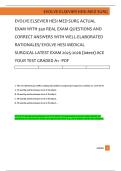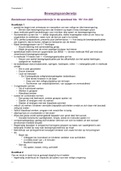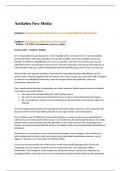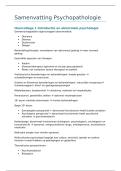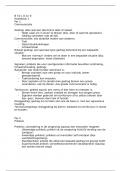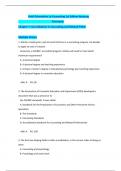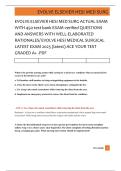book yourself. This summary is my interpretation of
what is relevant and what is not. You should use this as
extra study material
Inhoudsopgave:
Artikelen
Bergin & Garfield, H2 p. 2
Bergin & Garfield, H6 p. 7
Inleiding tot de gedragstherapie p. 15
Cliëntgerichte psychotherapie p. 22
Een therapeutische relatie p. 25
Imagery Rescripting as a Therapeutic Technique p. 29
Imagery Rescripting for Personality Disorders p. 32
Imagery Rescripting for Posttraumatic Stress Disorder p. 37
Mindfulness en psychotherapie p. 40
How Does Mindfulness Meditation Work? P. 44
Bewegen richting flexibiliteit met ACT p. 50
The Development of the Feighner Criteria p. 53
Boek: De DSM voorbij! van Jim van Os
H1: Positie van de DSM: heden en verleden p. 56
H2: Principes van de psychiatrische diagnostiek p. 59
H3: Principes van behandeling in de GGZ p. 61
H4: Mijn ervaring met the making of de DSM-5 p. 64
1
, Bergin & Garfield, H2: Methodology, Design, and
Evaluation in Psychotherapy Research
Kiesler (1971) recommended that therapy researchers make consistent use of designs in
which patient, therapist, and type of treatment are independent variables and dependent
variables are examined over time. The principles that guide researchers are:
1) The role of the scientific practitioner in psychotherapy research and practice.
Empirical evaluation of the efficacy and effectiveness of therapy is typically
considered necessary before widespread utilization can be sanctioned.
2) The importance of empirically supported treatment. The field has developed a
set of criteria, which help determine whether or not a treatment can be
considered “empirically supported”. Although the majority of researchers and
clinicians would likely agree that the evaluation of treatment is necessary, not all
agree on the best methods to identify effective treatments. Note that one study
does not prove the benefits of therapy, not does a single study raise treatment to
the level of being considered empirically supported. And even if treatment has
been supported empirically, however, the transport of the treatment from one
setting to another (research to service) represents a separate and important
issue.
Research should do more than simply provide evidence that some treatments are
worthier of health care resources than others. Treatment outcome research can also
offer valuable feedback to clinicians and health care providers.
Design considerations
The objective of the design is to distinguish intervention effect from any changes that
result from other factors. Extraneous factors must be “controlled”.
Random assignment
Random assignment does not guarantee comparability across conditions: it maximizes
the likelihood of comparability. But when random assignment is not applied, problems
arise. Two comparable participants can also be matched and put into different
conditions, as a form of randomization.
Selecting control condition(s)
Deciding which form of control condition to select for a particular study requires careful
deliberation.
In a waitlist condition, the participants in that condition expect that after a
certain period of time, they will receive treatment, and accordingly may anticipate
changes due to this treatment. The duration of the control condition should be the
same as the duration of the treatment condition. Waitlist-conditions also bring to
mind ethical dilemmas.
In an attention-placebo condition half of the participants receive the
treatment that is researched, and the other half receives another treatment.
Participants do not know which treatment is being researched. It’s important to
assess the participants expectations of the treatment on multiple occasions.
In a treatment-as-usual condition, the participants in that condition go on
with their treatment as usual. Ethical issues are accounted for in this condition,
because all of the participants receive treatment. When the experimental
treatment and the standard care intervention share comparable durations and
participant and therapist expectancies, the researcher can evaluate the relative
efficacy of the interventions.
2
,Evaluating treatment response across time
It is essential to first evaluate the participant functioning on the dependent variable prior
to the treatment (baseline). This is necessary to evaluate the comparability. Post-
treatment assessments of clients are essential to examine the comparative efficacy of
treatment versus control conditions. Follow-up assessments are also essential to
demonstrations of maintained treatment efficacy and are a signpost of methodological
rigor. Researchers can now evaluate treatment responses that may be nonlinear. Follow-
up evaluations can also help to identify differential treatment effects of considerable
clinical utility, and they may detect continued improvement.
Multiple treatment comparisons
Between-groups designs offer direct comparisons of one treatment with one or more
alternative active treatments. Multiple treatment comparisons are optimal when each
participant is randomly assigned to receive one and only one treatment condition, with
assignment resulting in the initial comparability of participants receiving each
intervention. Comparability across study therapists who are administering the different
treatments is preferred, although in actual practice therapist comparability can never
truly be achieved. Intervention procedures must be equated for key variables such as:
Duration;
Length, intensity and frequency of contacts with clients;
Credibility of the treatment rationale;
Treatment setting;
Degree of involvement of persons significant to the client.
Furthermore, measures should not be differentially sensitive to one treatment over the
other. Comparisons of psychological and psychopharmacological treatments are
especially challenging because psychological treatment effects may persist after
treatment, whereas the effects of medications may not persist when medications are
discontinued.
Procedural considerations
Defining the independent variable: manual-based treatments
Treatment must be adequately described and detailed to replicate the evaluation, or to
be able to show and teach others how to conduct the treatment. The use of treatment
manuals is needed for this. There has been a debate on these manuals: it has been
argued that manuals limit therapist creativity and place restrictions on the
individualization that the clinicians use. Manuals supposedly are overly directive, ignore
the moment-to-moment clinical decisions that therapists make and are inflexible. Barlow
(1989) noted that effective use of manual-based treatments must be preceded by
adequate training. Modern treatment manuals allow the therapist to attend to each
client’s specific circumstances, without deviating from the core treatment strategies.
Checking the integrity of the independent variable: treatment fidelity checks
Rigorous experimental research requires careful checking of the manipulated variable. To
help ensure that the treatments are indeed implemented as intended, it is wise to
require that a treatment plan be followed, that therapists are carefully trained, and that
sufficient supervision is available throughout. Evaluating the quality of treatment
provided is also of interest.
Sample section
Careful deliberations are required when choosing a sample to best represent the clinical
population of interest. A community subthreshold sample refers to a nontreatment-
seeking sample of participants, who may benefit from treatment but who may otherwise
only approximate clinically disordered individuals. Client diversity must also be
considered, but one can question the extent to which efficacy findings from European
3
, American samples can be generalized to ethnic minority samples. There is also a
potential bias in diagnoses and in the provision of mental health services to ethnic
minority patient. But to generalize to a diverse population, one must study a diverse
sample.
Study setting
It is not sufficient to demonstrate treatment efficacy within a highly selective setting.
Treatment outcome studies conducted in some settings may not generalize to other
settings. One should study that a treatment found to be efficacious within a research
clinical setting will be efficacious in clinical service setting.
Measurement considerations
Assessing the Dependent Variable(s)
There is no single measure that can serve as the sole indicator of clients’ treatment-
related gains. The multi-informant strategy, in which data on variables of interest are
collected from multiple reporters, can be particularly important when assessing children.
Some symptoms, however, may be less known to other reporters, and discrepancies
among informants are to be expected. A multimodal strategy relies on multiple modes
of assessment to evaluate an underlying construct of interest. It is rare that a treatment
produces uniform effects across assessed domains, that’s why it is recommended that
researchers conducting RCTs be explicit about the domains of functioning expected to
change, and the relative magnitude of such expected changes.
Data analysis
Data analysis is an active process through which we extract useful information from the
data we have collected in ways that allow us to make statistical inferences about the
larger population that a given sample was selected to represent.
Addressing missing data and attrition
A loss of research participants, called attrition, may occur at any point, and this can be
problematic for data analysis. Most researchers can expect nearly 20% of their sample to
withdraw or be removed from a study prior to completion. Researchers can conduct and
report two sets of analyses: (1) analyses of outcomes for treatment completers, and (2)
analyses of outcomes for all participants who were included at the time of
randomization. Researchers address missing endpoint data via one of several ways:
Last observation carried forward: assumes that participants who attrit remain
constant on the outcome variable from their last assessed point.
Substituting pretreatment scores for post-treatment scores: assumes that
participants who attrit remain constant on the outcome variable from the
pretreatment point.
Multiple imputation methods: imputes a range of values for the missing data,
generating a number of nonidentical datasets.
Mixed-effects models: relies on linear and/or logistic regression to address
missing data in the context of random and fixed effects.
It is recommended that researchers attempt to contact non-completing participants and
reevaluate them at the time when the treatment protocol would have ended.
Clinical significance
Statistical significance is achieved if the magnitude of the mean difference is beyond
what could have resulted by chance alone, but it does not provide evidence of clinical
significance: if the changes have an effect on the person’s perceived quality of life.
Clinical significance refers to the meaningfulness or persuasiveness of the magnitude of
4

